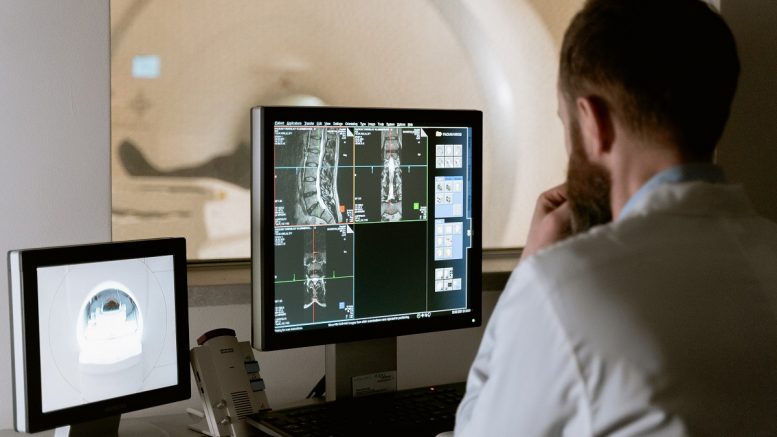Philip Brentnall, Product Strategy Manager and Clinical Lead at Wellbeing Software, discusses the five trends we can expect to see in 2022.
It is widely acknowledged that 2020 and 2021 have been two of the toughest years on record for the healthcare sector. With cancellation lists growing by the day and millions of patients still waiting for consultations, scans, or operations, the pressure on staff and infrastructure has been considerable.
Even before the COVID-19 pandemic, experts identified that 45% of radiologists experienced some form of burnout, mainly due to being overwhelmed by the administrative burden of the job and the substantial number of images that needed to be checked manually.
Adding to the pressure is the worldwide shortage of radiologists, significantly impacting screening services. The Clinical Radiology UK Workforce Census 2020 suggests that by 2025 there will be a 44% shortfall in the clinical radiology workforce, further burdening the existing radiology cohort.
Outdated infrastructure is also an issue. In the US there has been a huge drive to encourage healthcare facilities to adopt electronic health records, as there is no centralised system for patient data. So much so, the government has created a $27 billion incentive program to drive home the benefits of digital systems.
On the upside, the impact of the pandemic has given medical institutions an insight into the future of healthcare through an accelerated adoption of technology. In this article we will look in more detail at five trends we are expecting to see in radiology for 2022.
Artificial Intelligence
The adoption of innovative technologies can create significant benefits for individual workloads. Tools such as Artificial Intelligence (AI) and the infrastructure that supports it enable radiology departments to share information accurately, rapidly, and securely between multiple users and organisations.
AI can also help address the shortfall in radiologists. Through machine learning, the software has the potential to review and score scans much faster than the human eye. This is not to say it is physically replacing people but working alongside them to reduce the time necessary for certain tasks and improve overall efficiency.
For example, The Royal Australian and New Zealand College of Radiologists (RANCZR) recently reported a 27% increase in breast cancer detection rates as a result of using AI. It also found that by using artificial intelligent-based computer aided detection software, false marks fell by a remarkable 69%.
One element of artificial intelligence that has seen a sharp increase in demand is deep learning. This subset of AI has proven to be more adept when it comes to ingesting medical data and extracting valuable insights. Experts believe that the use of AI and deep learning will only continue to rise, with the expectation the global AI radiology market value will exceed $180 million by 2025.
Connected Radiology
A report published in 2015 suggested that radiologists needed to review an image every 3-4 seconds to keep up with their workloads, which has further highlighted the value of AI and connected systems.
Allowing radiology departments to share resources, improve workflows and reduce the impact of backlogs can add immense value. For this reason, we are seeing more healthcare facilities shifting toward shared imaging networks, as seen in the South West of England.
Pivoting to connected solutions not only helps mitigate burnout but should also be seen as an investment that enables ongoing improvements to diagnostics and patient care. With such strain on radiologists, a connected approach enables radiology departments to analyse complex data, reduce errors and increase efficiency.
Integrated Diagnostics
A clear focus for the NHS in 2022 will be addressing the vast backlog of outpatient appointments. In the 12 months to March 2021 over 20 million patients received cancellations due to the knock-on effects of COVID-19, so embracing products and services that drive improvements across departments will be key.
For example, the right technology provides healthcare facilities and medical professionals with access to vast amounts of data to inform patient prognosis and reduce the backlog of cancellations. There is no doubt the pandemic has accelerated the use of integrated diagnostics in hospitals. By integrating data and systems across diagnostic services, we can reduce the time and expense spent on processes and provide clinicians with faster access to complete result sets, speeding up clinical decisions and the commencement of treatment.
As a result, the Industrial Strategy Challenge Fund is providing over £200 million to support the development of precision medicine to improve early diagnosis and treatment. The aim of the fund is to encourage academics and professionals to increase their use of health and research data.
Remote Working
The pandemic has forced the world to adapt to remote working and radiologists are no different. In fact, COVID-19 has accelerated a shift from manual processes to digital platforms in the healthcare sector. AI can be integrated into any Picture Archiving and Communications System (PACS), which not only reduces the administrative burden on individuals but also enables them to work from home in an environment that allows complete focus on reviewing imagery.
With social distancing measures in place and a greater emphasis on remote working, radiologists need to be able to access reports, even when they are away from the original scan site. By bringing data together, radiologists across the country can always have instant access to the same centralised patient record. This helps them share resources and access scans remotely to make faster and better-informed decisions, enabling patients to move more seamlessly between sites and services.
RIS Reporting
With increasing demand for integrated information systems, the lines between PACS and RIS are becoming less defined. However, there are fundamental differences and limitations that dictate the role each plays in radiology.
While PACS has its strengths in radiology imaging systems – storing and retrieving medical images – a RIS streamlines department workflow and manages critical functions such as reporting, order entry, tracking and inventory. It is important that a PACS and RIS integrate seamlessly to ensure patients move through the radiology department quickly and safely.
Moving forward there is a clear need for a more comprehensive and integrated system able to process vast volumes of imagery and reduce manual workloads. This places radiology at the forefront of professions able to drive and make the most of digital acceleration in 2022 and beyond.





